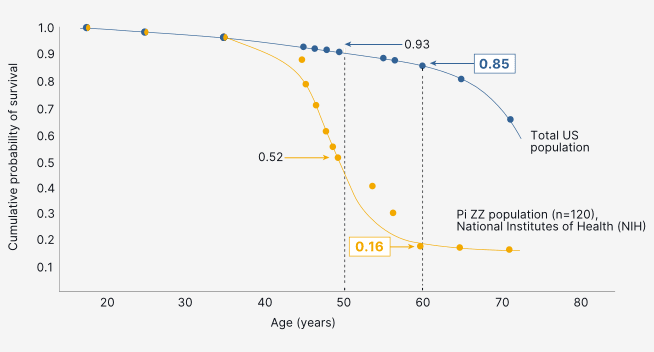What causes alpha-1?
Alpha1-antitrypsin (AAT) deficiency is caused by inheriting certain alleles in the SERPINA1 gene which results in deficient serum levels of alpha1 antitrypsin (AAT) or in a dysfunctional AAT protein.1-3
AAT is a protease inhibitor, a protein which normally functions to protect the lungs from structural damage by neutrophil elastase and sources of inflammation (cigarette smoke, environmental, and occupational pollution).1,2
Low levels of AAT create a proteolytic imbalance between AAT and neutrophil elastase, leaving the lungs vulnerable to alveolar damage.1-3
As a result, patients with severe AAT deficiency may be at increased risk of developing early-onset COPD and accelerated lung function decline.1,2

Origins of AAT deficiency
"The majority of chronic airway disease could potentially be associated with [AAT] deficiency, and doctors should have it on their minds so they can suspect it and diagnose it."
— José Luis López-Campos, MD
Virgen del Rocío University Hospital
Consequences of AAT deficiency
The most common mortality cause in patients with AAT deficiency is respiratory failure.1
In addition, a landmark study by the American Thoracic Society found that patients with AAT deficiency have a shortened lifespan.5
Survival analysis of individuals with severe AAT deficiency (PiZZ) vs total US population5

- Survival probabilities of the alpha-1 cohort (n=120) was 16% at 60 years of age, compared with 85% for the general population5
Study Design, 1988: All 120 Pi ZZ subjects evaluated as inpatients in NIH Clinical Center. Various demographic features, clinical findings, and electrocardiogram evaluations were obtained from medical records. Blood and urine laboratory findings were obtained through computerized archives of the Clinical Center Laboratories. Chest radiographs and scintigraphic scans were evaluated de novo at the time of this analysis, with knowledge of the diagnosis but without knowledge of any of the other data. Lung function tests were obtained from the computerized files of the Pulmonary Branch. Mortality data were obtained at the time of this analysis. Alpha1-antitrypsin protein phenotypes were determined by a combination of isoelectric focusing of serum, quantitation of AAT levels in serum, and family studies.5
* Reprinted with permission of the American Thoracic Society. Copyright 2012, American Thoracic Society.
Up Next: Alpha-1 Inheritance Pattern
References:
- Stoller JK, Aboussouan LS. A review of alpha-1 antitrypsin deficiency. Am J Respir Crit Care Med. 2012;185(3):246-259.
- Alpha-1 antitrypsin deficiency - symptoms, causes, treatment: NORD. National Organization for Rare Disorders. March 21, 2024. Accessed June 3, 2024. https://rarediseases.org/rare-diseases/alpha-1-antitrypsin-deficiency/.
- Silverman EK, Sandhaus RA. Clinical Practice. Alpha-1 antitrypsin deficiency. N Engl J Med. 2009;360(26):2749-2757.
- Köhnlein T, Welte T. Alpha-1 Antitrypsin Deficiency—Clinical Aspects and Management. Bremen, Germany;UNI-MED Verlag AG;2007.
- Brantly ML, Paul LD, Miller BH, Falk RT, Wu M, Crystal RG. Clinical features and history of the destructive lung disease associated with alpha-1-antitrypsin deficiency of adults with pulmonary symptoms. Am Rev Respir Dis. 1988;138(2):327-336.